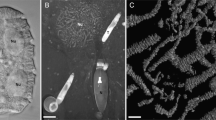Summary
Surface isolates or membrane skeletons from surface isolates can maintain the cell and surface form characteristic of euglenoids. We now report that the plasma membrane alone obtained by trypsin or urea digestion of surface isolates can also maintain surface form, but the membrane skeleton is able to produce striking changes in membrane organization. Trypsin digests microtubules, the membrane skeleton and partially digests the major integral membrane protein from surface isolates but does not alter the paracrystalline plasma membrane interior. Extraction of surface isolates with 4M urea leaves an insoluble plasma membrane and a subset of proteins arranged perpendicularly to the membrane surface. To resolve further the relationship between the plasma membrane and the membrane skeleton we have perturbed membrane organization by extraction of surface isolates with NaOH and find that readdition of the extract followed by neutralization restored important features of the membrane skeleton and caused patching of the membrane interior. Biochemically, the reassembled membrane skeleton consisted of 80 and 86 kD polypeptides and other less abundant proteins, and structurally the reassembled membrane skeleton was about the same thickness as the native membrane skeleton. Reassembly of the membrane skeleton appeared to be saturatable in that addition of an excess of extract had no effect on the thickness of the membrane skeletal layer. When the 80 kD protein was depleted from the reassembly mixture by affinity chromatography using Sepharose-bound monoclonal antibodies, the amount of 86 kD protein bound was significantly reduced, suggesting a dependance of 86 kD protein on 80 kD binding. A urea soluble fraction enriched in the 80 and 86 kD proteins was added to alkali-stripped membranes and 170 Å filaments were formed perpendicularly to the membrane surface. From the sum of these experiments we suggest that a) the native amorphous membrane skeleton ofEuglena may consist of a framework of 80 and 86 kD filaments arranged in a brush-like layer, b) the framework can direct plasma membrane organization, but once determined, membrane form remains stable to urea and trypsin but not to alkali, and c) new surface growth can in theory occur as an expansion of the brush-like layer by direct intercalation of filaments enriched in or consisting wholly of 80 and 86 kD proteins.
Similar content being viewed by others
Abbreviations
- BSA:
-
bovine serum albumin
- ELISA:
-
enzyme linked immunosorbant assay
- EF:
-
ectoplasmic fracture face
- IMPs:
-
intramembrane particles
- PF:
-
protoplasmic fracture face
References
Bennett V (1985) The membrane skeleton of human erythrocytes and its implications for more complex cells. Ann Rev Biochem 54: 273–304
Bré M-H, Philippe M, Fournet B, Delpech-Lafouasse S, Pouphile M, Lefort-Tran M (1986) Identification of cell surface glycoconjugates in a unicellular organism: modifications related to vitamin B12 deficiency. Eur J Cell Biol 41: 189–197
Bricheux G, Brugerolle G (1986) The membrane cytoskeleton complex of euglenids. I. Biochemical and immunological characterization of the epiplasmic proteins ofEuglena acus. Eur J Cell Biol 40: 150–159
Byers TJ, Branton D (1985) Visualization of the protein associations in the erythrocyte membrane skeleton. Proc Natl Acad Sci (USA) 82: 6153–6157
Dubreuil RR, Bouck GB (1985) The membrane skeleton of a unicellular organism consists of bridged, articulating strips. J Cell Biol 101: 1884–1896
Elgsaeter A, Stokke BT, Mikkelsen A, Branton D (1986) The molecular basis of erythrocyte shape. Science 234: 1217–1223
Fraker PJ, Speck JC (1978) Protein and cell membrane iodinations with a sparingly soluble chloroamide 1,3,4,6-tetrachloro-3a,6a-diphenylglycoluril. Biochem Biophys Res Comm 80: 849–857
Granger BL, Lazarides E (1984) Membrane skeletal protein 4.1 of avian erythrocytes is composed of multiple variants that exhibit tissue-specific expression. Cell 37: 595–607
Hanspal M, Luna E, Branton D (1984) The association of clathrin fragments with coated vesicle membranes. J Biol Chem 259: 11075–11082
Hofmann C, Bouck GB (1976) Immunological and structural evidence for patterned, intussusceptive surface growth in a unicellular organism. J Cell Biol 69: 693–715
Laemmli UK (1970) Cleavage of structural protein during the assembly of the head of bacteriophage T4. Nature 227: 680–685
Lebkowski JS, Laemmli UK (1982) Non-histone proteins and longrange organization of HeLa interphase DNA. J Mol Biol 156: 325–344
Lefort-Tran M, Bré MM, Ranck JL, Pouphile M (1980)Euglena plasma membrane during normal and vitamin B12 starvation growth. J Cell Sci 41: 245–261
Lowry OH, Rosebrough NJ, Farr AL, Randall RJ (1951) Protein measurements with the Folin phenol reagent. J Biol Chem 193: 265–275
Marchesi VT (1985) Stabilizing infrastructure of cell membranes. Ann Rev Cell Biol 1: 531–561
Miller KR, Miller GJ (1978) Organization of the cell membrane inEuglena. Protoplasma 95: 11–24
Murray JM (1981) Control of cell shape by calcium in theEuglenophyceae. J Cell Sci 49: 99–117
— (1984 a) Three-dimensional structure of a membrane microtubule complex. J Cell Biol 98: 283–295
Murray JM (1984 b) Disassembly and reconstitution of a membrane-microtubule complex. J Cell Biol 98: 1481–1487
Radosevich JA, Ma Y, Lee I, Salwen HR, Gould VE, Rosen ST (1985) Monoclonal antibody 44-3 A6 as a probe for a novel antigen found on human lung carcinomas with glandular differentiation. Cancer Res 45: 5808–5812
Spurr AR (1969) A low-viscosity epoxy resin embedding medium for electron microscopy. J. Ultrastruct Res 26: 31–43
Staufenbiel M, Lazarides E (1986) Ankyrin is fatty acid acylated in erythrocytes. Proc Natl Acad Sci USA 83: 318–322
Suzaki T, Williamson RE (1985) Euglenoid movement inEuglena fusca: evidence for sliding between pellicular strips. Protoplasma 124: 137–146
Suzaki T, Williamson RE (1986) Pellicular ultrastructure and euglenoid movement inEuglena ehrenbergii Klebs andEuglena oxyuris Schmarda. J Protozool 33: 165–171
Tuszynski GP, Knight L, Piperno JR, Walsh PN (1980) A rapid method for removal of [125I] iodide following iodination of protein solutions. Anal Biochem 106: 118–122
Author information
Authors and Affiliations
Additional information
This work was supported by a University of Illinois Fellowship to RRD and NSF grant DCB-8602793 to GBB.
Rights and permissions
About this article
Cite this article
Dubreuil, R.R., Bouck, G.B. Interrelationships among the plasma membrane, the membrane skeleton and surface form in a unicellular flagellate. Protoplasma 143, 150–164 (1988). https://doi.org/10.1007/BF01291159
Received:
Accepted:
Issue Date:
DOI: https://doi.org/10.1007/BF01291159




